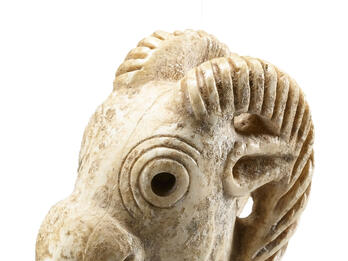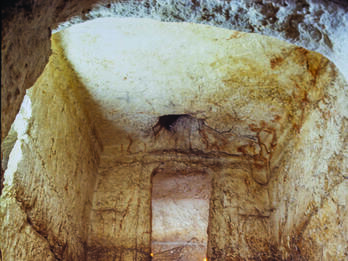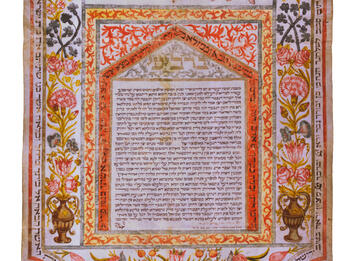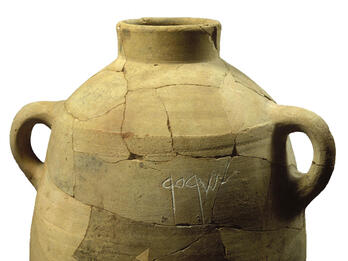Showing Results 1 - 10 of 43
Restricted
Image
The stopper is perforated at the bottom so that liquids, probably perfumes, can be poured from the jar through the male ibex’s mouth. The horns curl tightly back to the neck, perhaps to prevent them…
Places:
Lachish, Land of Israel (Tel Lakhish, Israel)
Date:
Iron Age IIB, 8th Century BCE
Subjects:
Categories:
Restricted
Image
This handle from Hazor, perhaps once attached to a mirror, depicts a winged humanoid with extended wings, grasping the branches or fronds of a young palm tree with both hands. It measures…
Places:
Hazor, Land of Israel (Tel Hazor, Israel)
Date:
Iron Age II, 8th Century BCE
Subjects:
Categories:
Restricted
Image
Steps at the rear of this burial chamber in the St. Étienne cemetery lead up to a second, inner one, with rock-cut, tub-shaped burial places, perhaps intended for important members of the families who…
Places:
Jerusalem, Land of Israel (Jerusalem, Israel)
Date:
Iron Age II, 9th–7th Century BCE
Subjects:
Categories:
Restricted
Image
The ketubah is a religious and legal contract of marriage. Traditionally, ketubot outline the conjugal and economic conditions of a marriage and are written in Aramaic. This ketubah was copied and…
Contributor:
Artist Unknown
Places:
Rome, Papal States (Rome, Italy)
Date:
1754
Subjects:
Categories:
Restricted
Image
This Biedermeier-style sofa from Danzig, with birch veneer over pine, may have been commissioned on the occasion of a marriage. The oval on the seat back contains an image of clasped hands, and the…
Contributor:
Artist Unknown
Places:
Danzig, Kingdom of Prussia (Gdańsk, Poland)
Date:
1838
Subjects:
Categories:
Restricted
Image
Paper cuts have been a tradition of Jewish folk art, with the earliest record of one dating to the fourteenth century. Given the widespread availability of paper in Europe by the mid-nineteenth…
Contributor:
Artist Unknown
Places:
Smyrna, Ottoman Empire (İzmir, Turkey)
Date:
1858–1859
Subjects:
Categories:
Restricted
Image
The ketubah is a religious and legal contract of marriage. Traditionally, it outlines the conjugal and economic conditions of a marriage and is written in Aramaic. This printed ketubah created by…
Contributor:
Zemah Davidsohn
Places:
New York City, United States of America
Date:
1863
Subjects:
Categories:
Restricted
Image
To/of the governor of the city. Translated by Shmuel Aḥituv, Ze’ev Meshel, and Esther Eshel.
Places:
Kuntillet Ajrud, Land of Israel (Kuntillat Jurayyah, Egypt)
Date:
Late 9th–Early 8th Century BCE
Subjects:
Categories:
Restricted
Text
A bath measure for the king.
Places:
Lachish, Land of Israel (Tel Lakhish, Israel)
Date:
8th Century BCE
Subjects:
Categories:
Restricted
Image
The top register of this plaque from Hazor depicts a crouching winged sphinx wearing the double crown of Upper and Lower Egypt. The lower register shows two stylized three-tiered palmettes. The…
Places:
Hazor, Land of Israel (Tel Hazor, Israel)
Date:
Iron Age IIB, first half of 8th century BCE











